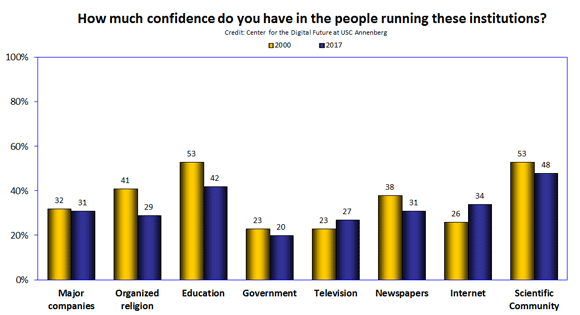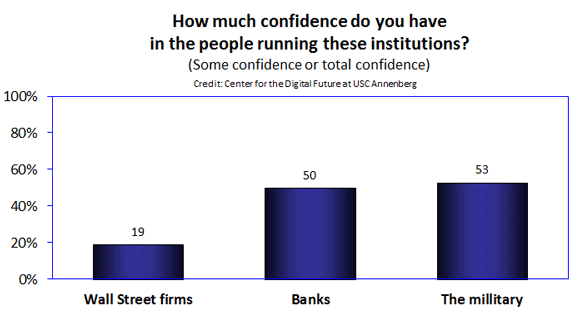The Center compares views about trust in institutions, 2000 vs. 2017
_______________
For societies to be stable, function effectively, and ultimately survive, members must have a basic level of trust in their social institutions: the family, government, economy, education, religion, and others. In recent years, there has been public dialogue about whether or not this necessary trust is on the wane in the United States. Gallup polls have measured a mostly declining American confidence in their basic institutions for more than a decade.
Reflecting this trend, soon after the election of Donald Trump, Clare Malone of FiveThirtyEight wrote an article titled, “Americans Don’t Trust Their Institutions Anymore.” Malone argued that Trump’s victory was in part due to his campaign messaging that was in tune with a fundamental disillusionment of many Americans in their institutions.
But has trust really changed?
The Center’s studies look at institutional trust in the United States. We first measured levels of trust back in the year 2000 for “Surveying the Digital Future,” our broad annual longitudinal study of the impact of digital technology on users and non-users. We repeated these measures in 2017 as part of our upcoming Future of Money and Banking Study.
Our findings show that with the exception of television and the internet, trust has declined somewhat in all of the other institutions measured in our study.
In our survey, we asked respondents their level of confidence in the people running several institutions. Comparing results from 2000 with 2017 shows:
- We see virtually the same level of trust in major companies, with 31.5% expressing confidence or total confidence in 2000 compared to 30.7% in 2017.
- We found small declines in confidence in the government in 2000 vs. 2017 (22.6% vs. 19.6%) and the scientific community (52.5% vs. 47.9%).
- There were larger declines in trust in newspapers (37.9% vs. 30.7%) and education (52.5% vs. 41.7%).
- The biggest decline came for trust in organized religion. In 2000, 40.6% of people expressed confidence or total confidence in organized religion, while in 2017 only 28.5% did.
- Which organizations do Americans trust more in 2017 compared to 2000? Respondents voiced an increased level of trust in two media institutions, expressing confidence or total confidence in television (up from 23.3% to 26.5%) and the internet (up from 26.3% to 33.8%).

In 2017 we also asked about three additional institutions: respondents reported some confidence or total confidence in the military (53%), banks (50%), and Wall Street firms (at 19.3% — the lowest level of confidence reported for any institution in either 2000 or 2017).
Our current questions on trust in institutions were asked as part of our study of how digital technology is transforming the world of banking and money. It is notable to see that in the face of the current digital disruption, the military is presently the only institution on our list that Americans have more trust in than banks.

So despite ongoing change in the social patterns of thought and action regarding money and banking, trust in banks is relatively high, with half of Americans having confidence or total confidence in them. For now, it seems that disquiet about banks does not have to be high on our list of concerns about declining American confidence in institutions.
__________
See all Web Insights
August 29, 2017

